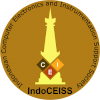A Covid-19 Sentiment Analysis on Twitter Using K-Nearest Neighbours
Abstract
Full Text:
PDFReferences
Chandra, D. N., Indrawan, G., & Sukajaya, I. N. (2016). Klas ifikasi Berita Lokal Radar Malang Menggunakan Metode Naïve Bayes Dengan Fitur N-Gram. Jurnal Ilmiah Teknologi Dan Informasi ASIA (JITIKA).
Kalokasari, D. H., Shofi, I. M., & Setyaningrum, A. H. (2017). IMPLEMENTASI ALGORITMA MULTINOMIAL NAIVE BAYES CLASSIFIER PADA SISTEM KLASIFIKASI SURAT KELUAR (Studi Kasus : DISKOMINFO Kabupaten Tangerang). JURNAL TEKNIK INFORMATIKA. https://doi.org/10.15408/jti.v10i2.6199
Junianto, E., & Riana, D. (2017). Penerapan PSO Untuk Seleksi Fitur Pada Klasifikasi Dokumen Berita Menggunakan NBC. Jurnal Informatika.
Nurhuda, F., Widya Sihwi, S., & Doewes, A. (2016). Analisis Sentimen Masyarakat terhadap Calon Presiden Indonesia 2014 berdasarkan Opini dari Twitter Menggunakan Metode Naive Bayes Classifier. Jurnal Teknologi & Informasi ITSmart. https://doi.org/10.20961/its.v2i2.630
Zhao, W. X., Jiang, J., Weng, J., He, J., Lim, E. P., Yan, H., & Li, X. (2011). Comparing twitter and traditional media using topic models. Lecture Notes in Computer Science (Including Subseries Lecture Notes in Artificial Intelligence and Lecture Notes in Bioinformatics).
Pratama, B. Y., & Sarno, R. (2016). Personality classification based on Twitter text using Naive Bayes, KNN and SVM. Proceedings of 2015 International Conference on Data and Software Engineering, ICODSE 2015. https://doi.org/10.1109/ICODSE.2015.7436992
Montejo-Ráez, A., Martínez-Cámara, E., Martín-Valdivia, M. T., & Ureña-López, L. A. (2014). Ranked WordNet graph for Sentiment Polarity Classification in Twitter. Computer Speech and Language. https://doi.org/10.1016/j.csl.2013.04.001
Kobayashi, V. B., Mol, S. T., Berkers, H. A., Kismihók, G., & Den Hartog, D. N. (2018). Text Mining in Organizational Research. Organizational Research Methods. https://doi.org/10.1177/1094428117722619
Hashimi, H., Hafez, A., & Mathkour, H. (2015). Selection criteria for text mining approaches. Computers in Human Behavior. https://doi.org/10.1016/j.chb.2014.10.062
Zulfa, I., & Winarko, E. (2017). Sentimen Analisis Tweet Berbahasa Indonesia Dengan Deep Belief Network. IJCCS (Indonesian Journal of Computing and Cybernetics Systems). https://doi.org/10.22146/ijccs.24716
Tong, Z., & Zhang, H. (2016). A Text Mining Research Based on LDA Topic Modelling. https://doi.org/10.5121/csit.2016.60616
Deviyanto, A., & Wahyudi, M. D. R. (2018). Penerapan Analisis Sentimen Pada Pengguna Twitter Menggunakan Metode K-Nearest Neighbor. Jiska. JISKA (Jurnal Informatika Sunan Kalijaga). https://doi.org/10.14421/jiska.2018.31-01
Jiang, S., Pang, G., Wu, M., & Kuang, L. (2012). An improved K-nearest-neighbor algorithm for text categorization. Expert Systems with Applications. https://doi.org/10.1016/j.eswa.2011.08.040
Trishna, T. I., Emon, S. U., Ema, R. R., Sajal, G. I. H., Kundu, S., & Islam, T. (2019). Detection of Hepatitis (A, B, C and E) Viruses Based on Random Forest, K-nearest and Naïve Bayes Classifier. 2019 10th International Conference on Computing, Communication and Networking Technologies, ICCCNT 2019. https://doi.org/10.1109/ICCCNT45670.2019.8944455
Istia, S. S., & Purnomo, H. D. (2018). Sentiment analysis of law enforcement performance using support vector machine and K-nearest neighbor. Proceedings - 2018 3rd International Conference on Information Technology, Information Systems and Electrical Engineering, ICITISEE 2018. https://doi.org/10.1109/ICITISEE.2018.8720969
Sriwanna, K. (2018). Text classification for subjective scoring using K-nearest neighbors. 3rd International Conference on Digital Arts, Media and Technology, ICDAMT 2018.
Vijayan, V. K., Bindu, K. R., & Parameswaran, L. (2017). A comprehensive study of text classification algorithms. 2017 International Conference on Advances in Computing, Communications and Informatics, ICACCI 2017. https://doi.org/10.1109/ICACCI.2017.8125990
Ary, M. (2016). Pengklasifikasian Karakteristik Mahasiswa Baru Dalam Memilih Program Studi Menggunakan Analisis Cluster. Jurnal Informatika. https://doi.org/10.31311/ji.v2i1.58
DOI: https://doi.org/10.33633/jais.v7i1.5984
Article Metrics
Abstract view : 235 timesPDF - 214 times
Refbacks
- There are currently no refbacks.
Journal of Applied Intelligent System (e-ISSN : 2502-9401, p-ISSN : 2503-0493) is published by Department of Informatics Universitas Dian Nuswantoro Semarang and IndoCEISS.


Journal of Applied Intelligent System indexed by :
This journal is under licensed of Creative Commons Attribution 4.0 International License.

_.png)






